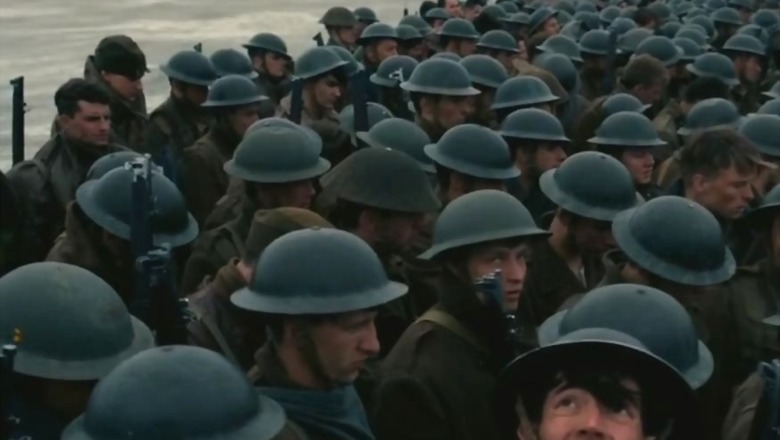
views
Christopher Nolan’s recent war film Dunkirk has elicited a spectrum of responses. Reviewers hailed it as “spare, stunning, extraordinarily ambitious”, showcasing “the quiet heroism of pilots, sailors, soldiers and civilians”; others found it “bloodless, boring and empty.”
Many commented on its mythmaking. Even far-right, anti-immigrant British politician Nigel Farage waded into this opinion pool, urging “every youngster to go out and watch Dunkirk, presumably not simply for its spectacular cinematography. What does this “paean to patriotic unity”, this “Brexiter version of British identity” say about the cultural memory of the Second World War in the West? What myths does a film with a $100 million budget shore up? Perhaps the biggest illusion that persists about the Second World War, despite the best efforts of recent historians, is it being a ‘white man’s war’. More than five million men from across the British Empire signed up for the war effort, out of which two-and-a-half million were from undivided India. The Eighth Army, for instance, fighting in the North African and Italian campaigns, was one-quarter British and three-quarters colonial troops in 1941. The Fourteenth Army – battling the Japanese in Burma and dubbed ‘the forgotten army’ even in the 1940s – included Indians, Gurkhas, West Africans, Somalis, Rhodesians as well as men from the south of England.
The politics of remembrance is not just about recounting numbers, of course, but in recognising presence. Force K6, formed from the Royal Indian Army Service Corps and consisting mainly of four mule companies, was sent to France to support the British Expeditionary Forces when war first broke out. About 600 such men were present at the Dunkirk evacuation, distraught at leaving their mules behind – these Indian men loved their animals. Among them was 33 year-old Dost Muhammed, a sepoy in the 22 Mule Company, whose home was nearly 5,000 miles away, in Rawalpindi in modern-day Pakistan. Dost Muhammed died in France. The Dunkirk memorial, maintained by the Commonwealth War Graves Commission, remembers him; Nolan’s film does not.
The film’s forgetting is not simply of Indian men but African soldiers too. The blink-and-you-miss-it shot of Senegalese tirailleurs or French colonial infantry soldiers with no speaking parts hints at the possibility of other narratives, also born from imperial roots, which is silenced. The clue to these untold lives lies in the name of the war itself: this was a world war, and not simply a Western one, as Nolan would have us believe.
If colonial troops from the Second World War have such little place in public memory in the West, how do they fare in the former colonies, post-independence? For modern South Asia, imperial war service is an uncomfortable history in some ways, signifying support for the British war effort when the fight for undivided India’s freedom from British rule was at its peak.
It was, in fact, Indian mule companies being summarily sent off to France to assist the British Expeditionary Forces, without the Viceroy, Lord Linlithgow, consulting the burgeoning Indian political leadership that eventually led to Gandhi launching the 1942 Quit India movement. Beginning as protests against this undemocratic inclusion in the Second World War, Quit India evolved into mass agitations against 200 years of British colonial rule, suppressed in turn by an occupation-style use of force. Colonised people’s destinies were, then, linked to that of Dunkirk, and would untangle in relation to this global conflict.
With no conscription introduced by the British in undivided India, why did two-and-a-half million men – the much-vaunted largest volunteer army figure – sign up to this war in the first place? The British Empire needed men urgently, and requirements for entry were relaxed, including the acceptance of underweight and anaemic applicants – those most desperate for a steady income. War service gave them access to better food and medicine.
However, even to those more physically robust, this war became many things aside from supporting/opposing British imperialism or Hitler’s fascism. Participating in the war was an opportunity for employment, a means of protecting entitled access to jobs especially in the traditional recruiting region of the Punjab, and a tool for securing particular community rights. Force K6 in France was the first tranche of many hundreds of thousands more Indian troops who journeyed to international battlefronts.
Studying history in school in India, I had no idea how mired the country’s national history was in that distant European/American event – the Second World War. I did not know that that thousands of Indians serving in the British Merchant Navy as ‘lascars’ connected Chittagong and Sylhet to Liverpool and Glasgow, that the Bengal Famine with its three million dead was directly linked to wartime inflation and Churchill’s food policies, or that nearly a million Indians built airstrips in Bengal and Assam – launching pads for eventual Japanese defeat in Burma.
Nolan’s ‘Dunkirk’ reinforces a narrative where the colour of war memory remains uniform. This homogeneity must be challenged. For, more than stone memorials, it is the stories we tell, and the lives we remember, that create a shared cultural memory of terrible global violence.
— The author Diya Gupta is a PhD researcher at King’s College London, UK. She studies the Indian soldiers’ experiences in the Second World War from a literary and cultural perspective. Views are personal.
















Comments
0 comment